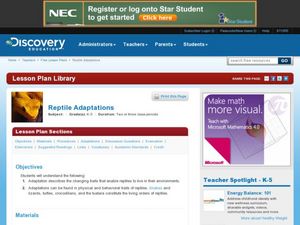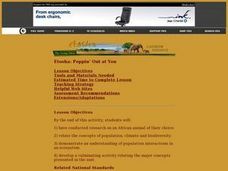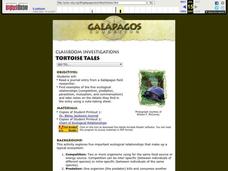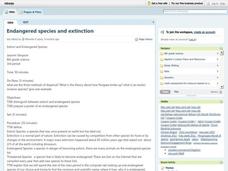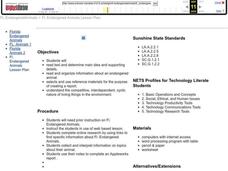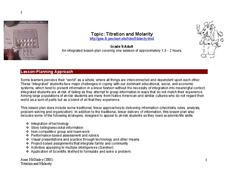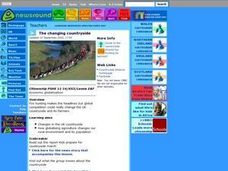American Physiological Society
Sticky Adaptations A Lesson on Natural Selection
Now you see it, now you don't! The stick bug exhibits the ability to disappear into a wooded environment. Why does this adaptation manifest in some species, but not in others? Life science high schoolers explore animal adaptations in...
Curated OER
Reptile Adaptations
Students research animal adaptations. In this adaptations lesson, students research the physical and behavioral adaptations of animals. Students create a diagram of their animal labeling it's adaptations.
Curated OER
Etosha: Poppin' Out at You
Tenth graders research an African animal of their choice and relate the concepts of population, climate and biodiversity to their animal. They examine how population interacts in an ecosystem.
Curated OER
Habitats and Adaptations
Young scholars research and describe the habitat and adaptations of a reef animal. After the student is assigned a habitat, they design and draw a cresture adapted to eat each food and to live in each habitat.
Curated OER
Tortoise Tales
Students read journal entry from a Gal??pagos field researcher, find examples of five ecological relationships (competition, predation, parasitism, mutualism, and commensalism) and take notes on the details they find in the entry using a...
Curated OER
Endangered Species and Extinction
Eighth graders determine the difference between extinction and endangered species. Using the internet, they research one endangered species, identify its common and specific name, where it lives and what it eats. To end the lesson,...
Curated OER
A Cat-and-Mouse Story
High schoolers view an animated PowerPoint program that teaches possessive vocabulary in Spanish. They review English grammar. Students access high-frequency verbs and additional vocabulary.
Curated OER
Critters in Your Own Backyard
Young scholars identify various animals and their habitats, as well as their specific traits In this animal habitat lesson, students list animals they've seen in their backyard. Young scholars select one animal and do research. Students...
Curated OER
What If We Run Out?
Students explore the consequences of shrinking habitats and the human impact on wildlife populations. They participate in a game to study the consequences and describe the preservation of animal habitats.
Curated OER
Endangered Animals
Students discuss animals then research endangered animals using the computer and the Internet. They organize information then create a report on a chosen animal using Appleworks.
Curated OER
Shelter
Pupils study shelter and how plants, animals, and people must have shelter to survive. In this shelter lesson, students read paragraphs about various shelters and their necessity with plants, animals, and people.
Curated OER
Art Reflecting Life
Have your young television viewers discuss popular shows among their peers. After choosing one show to analyze, middle and high schoolers read about the 2007-2008 network television lineup with the New York Times article "Gauging...
Curated OER
How and Why Has the White House Changed?
Students examine changes the White House has undergone in the past two centuries. They view and discuss online images and designs, compare diagrams, read information from various websites, and answer discussion questions.
Curated OER
How and Why Has the White House Changed?
Students view original design drawings of the White House and discuss ways it has been changed. They view images of the white house from specified dates and discuss the changes that were made from one to the other, as well as reasons for...
Curated OER
The Circle of Life: Food Chain
Students develop a flow chart using computer software to show a food chain combination. For this food chain lesson, students are first read The Great Kapok Tree by Lynne Cherry, then they create a story map of the story. ...
Curated OER
Prey or Pray? Could YOU Escape a Cheetah?
Tenth graders estimate the size of an adult cheetah by research and measurement of a picture. They determine the approximate distance and speed of the cheetah from a filmed chase and compare that to their own running speed.
Curated OER
Cypress/Tupelo Swamps
Students study the geologic history of terrain, soils, and drainage patterns. They recognize ecological processes that determine the dynamic nature of habitats. They investigate the influence of human activity on the landscape.
Curated OER
Butterfly Life Cycle
Students identify the stages in the butterfly life cycle. After completing a KWL chart, students participate in a brief lecture on the stages of the butterfly life cycle. Using reading books and Internet research, students complete an...
Curated OER
How Atoms Work
Students explore the concept of atoms and how they combine to form molecules and compounds. In pairs, they read an article on how atoms work and discuss the main points. They draw atoms and write a paragraph about their elements.
Curated OER
Titration and Molarity
Students investigate the concept of molarity and its relationship to the concentration of a solution. After mixing chemical solutions, they calculate how many moles of acid and base should be in each solution. They record their results...
Curated OER
The "Write Sport"
Fifth graders discuss the history of sports in Iowa. In this sports lesson plan, 5th graders write a friendly sports letter and a how to directional writing. They write five entries in their journal from the point of view of a piece of...
Curated OER
The Changing countryside
Pupils draw a poster showing the costs and benefits of opening up Britain's farmers to the global marketplace. They use a piece of A4 or A3 paper in landscape. Students draw a vertical line to split the page in two. On the left place...
Curated OER
Investigation 11 - Utah Fish
Fourth graders examine a particular Utah fish and then create a poster that shares what they learned. They access websites imbedded in this plan to aide them in their research.

